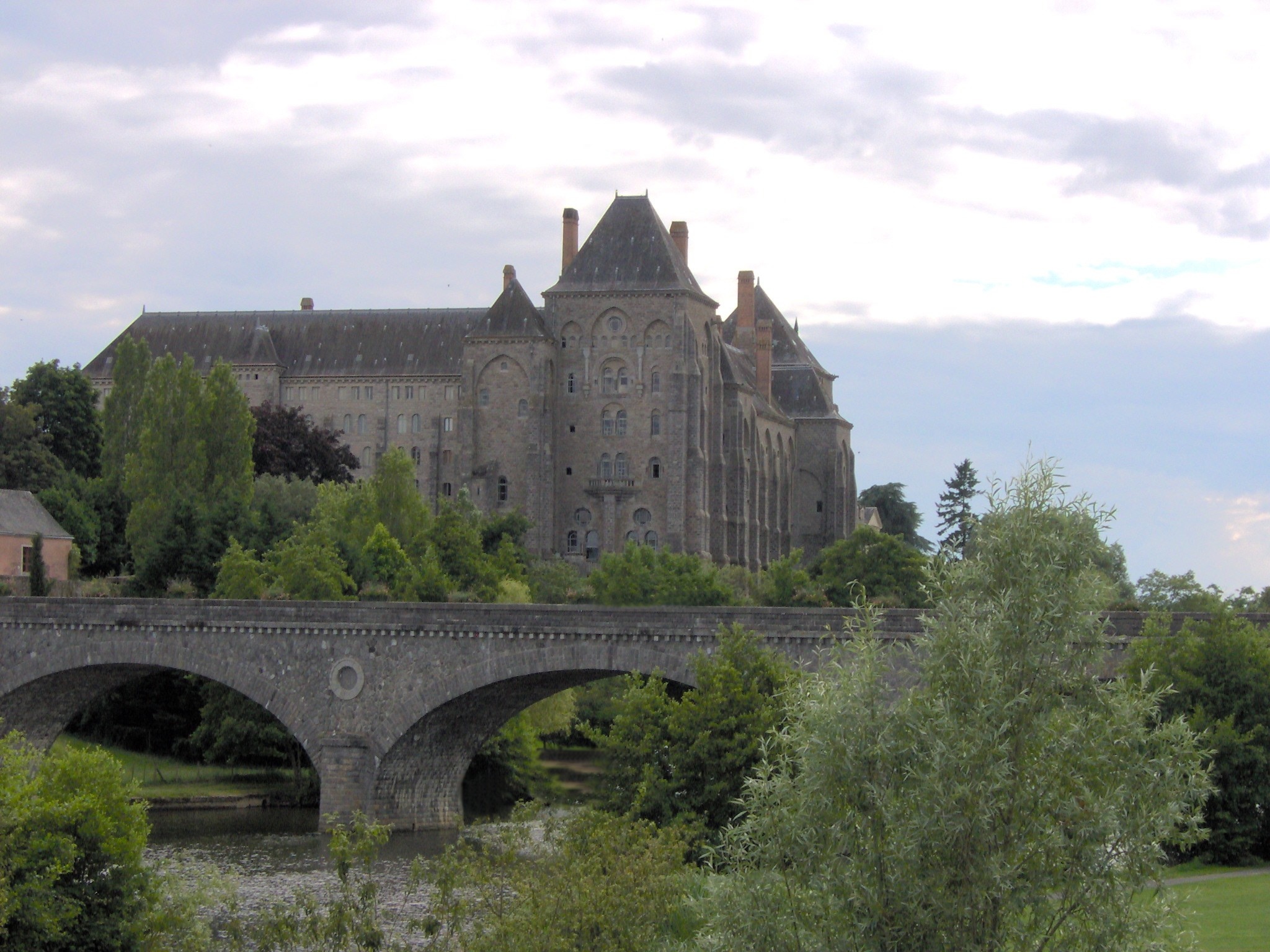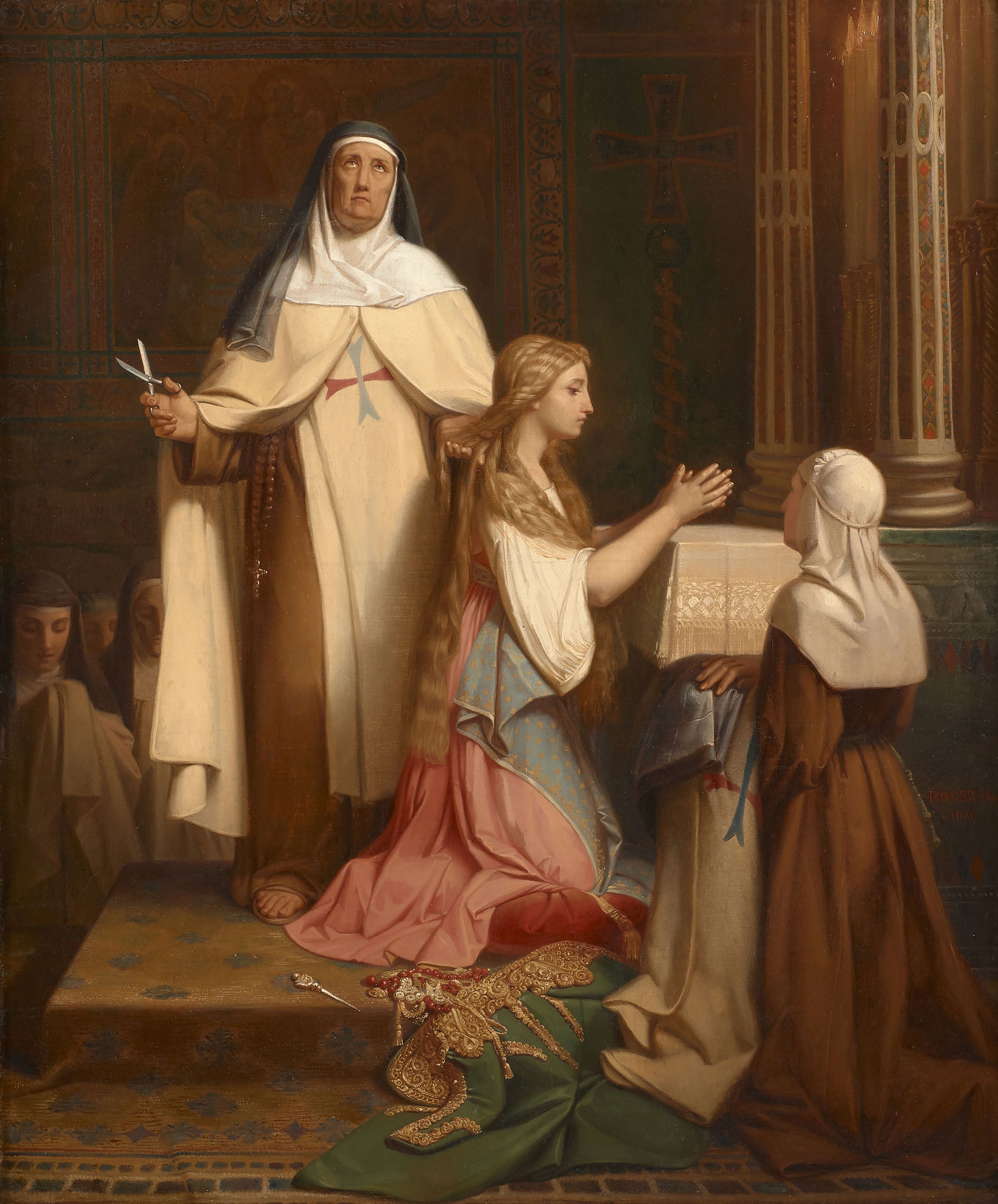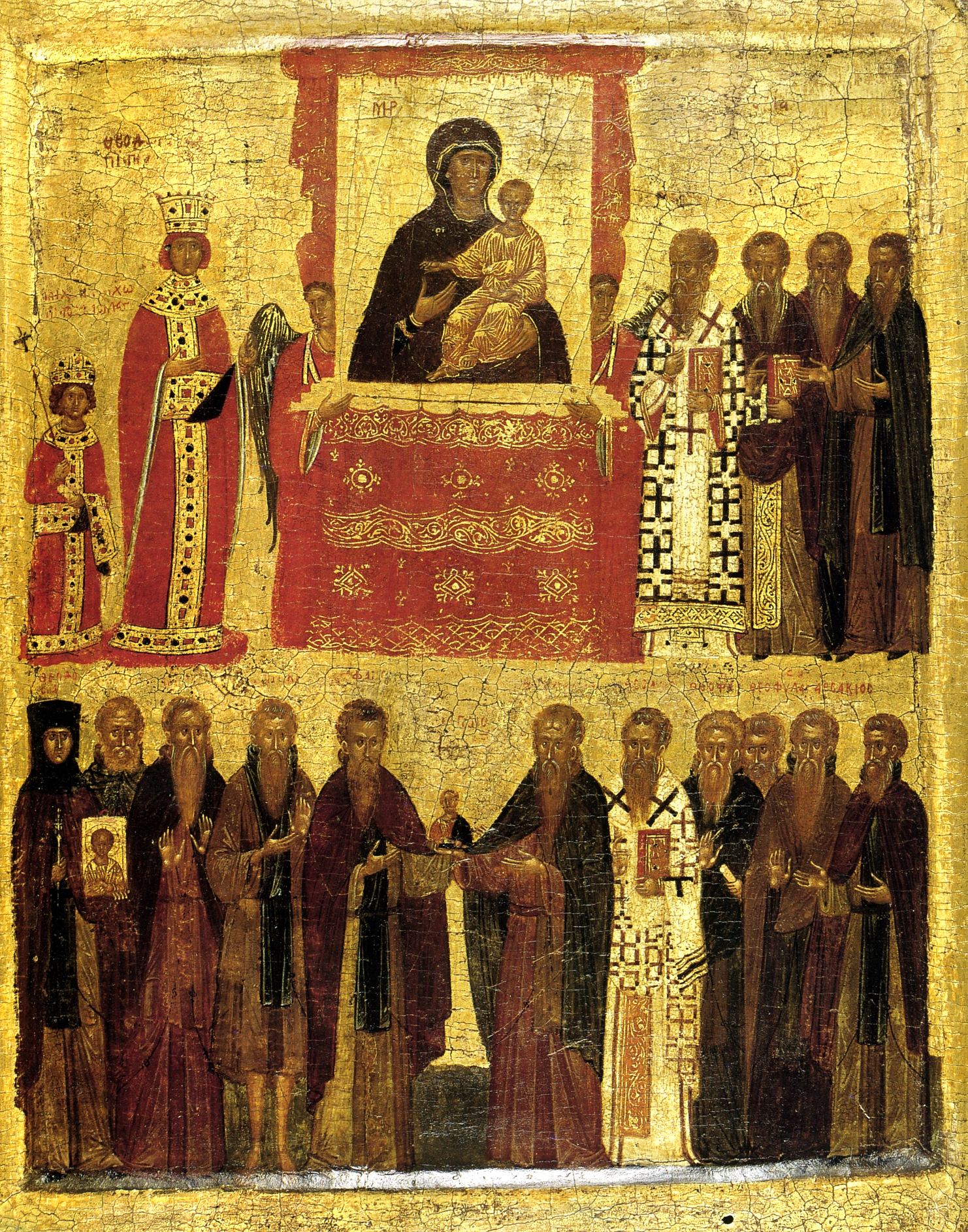|
Priory Of Solesmes
Solesmes Abbey or St. Peter's Abbey, Solesmes () is a Benedictine monastery in Solesmes, Sarthe, France, and the source of the restoration of Benedictine monastic life in the country under Dom Prosper Guéranger after the French Revolution. The current abbot is the Right Reverend Dom Abbot Geoffrey Kemlin, O.S.B., elected in 2022. Parish Prior to the foundation of Solesmes Abbey, a parish existed at the site. This parish may have been founded at the site as early as the 5th century. Evidence also suggests that the site may first have been built upon in the 6th or 7th century. This original parish was surrounded by a large cemetery. Sarcophagi found at the site suggest that they may go back to the Merovingian period. These sites are still preserved to this day. Priory Solesmes Abbey was founded in 1010 by Geoffrey, Lord of Sablé, who donated the monastery and its farm to the Benedictine monks of the Saint-Pierre de la Couture Abbey, "for the redemption of his soul and tho ... [...More Info...] [...Related Items...] OR: [Wikipedia] [Google] [Baidu] |
Monastery
A monastery is a building or complex of buildings comprising the domestic quarters and workplaces of Monasticism, monastics, monks or nuns, whether living in Cenobitic monasticism, communities or alone (hermits). A monastery generally includes a place reserved for prayer which may be a chapel, Church (building), church, or temple, and may also serve as an Oratory (worship), oratory, or in the case of Cenobium, communities anything from a single building housing only one senior and two or three junior monks or nuns, to vast complexes and estates housing tens or hundreds. A monastery complex typically comprises a number of buildings which include a church, dormitory, cloister, refectory, library, Wiktionary:balneary, balneary and Hospital, infirmary and outlying Monastic grange, granges. Depending on the location, the monastic order and the occupation of its inhabitants, the complex may also include a wide range of buildings that facilitate self-sufficiency and service to the commun ... [...More Info...] [...Related Items...] OR: [Wikipedia] [Google] [Baidu] |
Basilica
In Ancient Roman architecture, a basilica (Greek Basiliké) was a large public building with multiple functions that was typically built alongside the town's forum. The basilica was in the Latin West equivalent to a stoa in the Greek East. The building gave its name to the ''basilica'' architectural form. Originally, a basilica was an ancient Roman public building, where courts were held, as well as serving other official and public functions. Basilicas are typically rectangular buildings with a central nave flanked by two or more longitudinal aisles, with the roof at two levels, being higher in the centre over the nave to admit a clerestory and lower over the side-aisles. An apse at one end, or less frequently at both ends or on the side, usually contained the raised tribunal occupied by the Roman magistrates. The basilica was centrally located in every Roman town, usually adjacent to the forum and often opposite a temple in imperial-era forums. Basilicas were also ... [...More Info...] [...Related Items...] OR: [Wikipedia] [Google] [Baidu] |
Prosper Guéranger
Prosper Louis Pascal Guéranger (; 4 April 1805 – 30 January 1875) was a French priest and Benedictine monk, who served for nearly 40 years as the abbot of the monastery of Solesmes (which he founded among the ruins of a former priory at Solesmes). Through the new Abbey of Solesmes, he became the founder of the French Benedictine Congregation (now the Solesmes Congregation), which re-established Benedictine monastic life in France after it had been wiped out by the French Revolution. Guéranger was the author of '' The Liturgical Year'', a popular commentary which covers every day of the Catholic Church's liturgical cycles in 15 volumes. He was well regarded by Pope Pius IX, and was a proponent of the dogmas of the Immaculate Conception and of papal infallibility. Guéranger is credited with reviving the Benedictine Order in France, and with promoting the adoption of the liturgical books of the Roman Rite throughout France, an important element in the Liturgical Movement, ... [...More Info...] [...Related Items...] OR: [Wikipedia] [Google] [Baidu] |
Abbaye Saint-Pierre De Solesmes
Solesmes Abbey or St. Peter's Abbey, Solesmes () is a Benedictine monastery in Solesmes, Sarthe, France, and the source of the restoration of Benedictine monastic life in the country under Dom Prosper Guéranger after the French Revolution. The current abbot is the Right Reverend Dom Abbot Geoffrey Kemlin, O.S.B., elected in 2022. Parish Prior to the foundation of Solesmes Abbey, a parish existed at the site. This parish may have been founded at the site as early as the 5th century. Evidence also suggests that the site may first have been built upon in the 6th or 7th century. This original parish was surrounded by a large cemetery. Sarcophagi found at the site suggest that they may go back to the Merovingian period. These sites are still preserved to this day. Priory Solesmes Abbey was founded in 1010 by Geoffrey, Lord of Sablé, who donated the monastery and its farm to the Benedictine monks of the Saint-Pierre de la Couture Abbey, "for the redemption of his soul and tho ... [...More Info...] [...Related Items...] OR: [Wikipedia] [Google] [Baidu] |
Concordat Of 1801
The Concordat of 1801 was an agreement between the First French Republic and the Holy See, signed by First Consul Napoleon Bonaparte and Pope Pius VII on 15 July 1801 in Paris. It remained in effect until 1905, except in Alsace–Lorraine, where it remains in force. It sought national reconciliation between the French Revolution and Catholics and solidified the Roman Catholic Church as the majority church of France, with most of its civil status restored. This resolved the hostility of devout French Catholics against the revolutionary state. It did not restore the vast Church lands and endowments that had been seized during the Revolution and sold off. Catholic clergy returned from exile, or from hiding, and resumed their traditional positions in their traditional churches. Very few parishes continued to employ the priests who had accepted the Civil Constitution of the Clergy of the revolutionary regime. While the Concordat restored much power to the papacy, the balance o ... [...More Info...] [...Related Items...] OR: [Wikipedia] [Google] [Baidu] |
Jersey
Jersey ( ; ), officially the Bailiwick of Jersey, is an autonomous and self-governing island territory of the British Islands. Although as a British Crown Dependency it is not a sovereign state, it has its own distinguishing civil and government institutions, so qualifies as a small nation or island country. Located in Northwestern Europe, off the coast of north-west France, it is the largest of the Channel Islands and is from Normandy's Cotentin Peninsula. The Bailiwick consists of the main island of Jersey and some surrounding uninhabited islands and rocks including Les Dirouilles, Les Écréhous, Les Minquiers, and Les Pierres de Lecq. Jersey was part of the Duchy of Normandy, whose dukes became kings of England from 1066. After Normandy was lost by the kings of England in the 13th century, and the ducal title surrendered to France, Jersey remained loyal to the English Crown, though it never became part of the Kingdom of England. At the end of the Napoleonic ... [...More Info...] [...Related Items...] OR: [Wikipedia] [Google] [Baidu] |
Religious Vows
Religious vows are the public vows made by the members of religious communities pertaining to their conduct, practices, and views. In the Buddhist tradition, in particular within the Mahayana and Vajrayana traditions, many different kinds of religious vows are taken by the lay community as well as by the monastic community, as they progress along the path of their practice. In the monastic tradition of all schools of Buddhism, the Vinaya expounds the vows of the fully ordained Nuns and Monks. In the Christian tradition, such public vows are made by the religious cenobitic and eremitic of the Catholic Church, Lutheran Churches, Anglican Communion, and Eastern Orthodox Churches, whereby they confirm their public profession of the evangelical counsels of poverty, chastity, and obedience or Benedictine equivalent. The vows are regarded as the individual's free response to a call by God to follow Jesus Christ more closely under the action of the Holy Spirit in a particular form of ... [...More Info...] [...Related Items...] OR: [Wikipedia] [Google] [Baidu] |
National Constituent Assembly (France)
The National Constituent Assembly () was a constituent assembly in the Kingdom of France formed from the National Assembly (French Revolution), National Assembly on 9 July 1789 during the first stages of the French Revolution. It dissolved on 30 September 1791 and was succeeded by the Legislative Assembly (France), Legislative Assembly. Background Estates-General The Estates General of 1789, ''(Etats Généraux)'' made up of representatives of the three estates, which had not been convened since 1614, met on 5 May 1789. The Estates-General reached a deadlock in its deliberations by 6 May. The representatives of the Third Estate attempted to make the whole body more effective and so met separately from 11 May as the ''Communes''. On 12 June, the ''Communes'' invited the other Estates to join them: some members of the Estates of the realm#First Estate, First Estate did so the following day. On 17 June 1789, the ''Communes'' approved s:Motion of Abbé Sieyès, the motion made by Si ... [...More Info...] [...Related Items...] OR: [Wikipedia] [Google] [Baidu] |
Congregation Of Saint Maur
The Congregation of St. Maur, often known as the Maurists, were a congregation of French Benedictines, established in 1621, and known for their high level of scholarship. The congregation and its members were named after Saint Maurus (died 565), a disciple of Saint Benedict credited with introducing the Benedictine rule and life into Gaul. The congregation was suppressed and its superior-general executed during the French Revolution. History At the end of the 16th century the Benedictine monasteries of France had fallen into a state of disorganization and laxity. In the Abbey of St. Vanne near Verdun a reform was initiated by Dom Didier de la Cour, which spread to other houses in Lorraine, and in 1604 the reformed Congregation of St. Vanne was established, the most distinguished members of which were Ceillier and Calmet. A number of French houses joined the new congregation; but as Lorraine was still independent of the French crown, it was considered desirable to form on the ... [...More Info...] [...Related Items...] OR: [Wikipedia] [Google] [Baidu] |
In Commendam
In canon law, commenda (or ''in commendam'') was a form of transferring an ecclesiastical benefice ''in trust'' to the ''custody'' of a patron. The phrase ''in commendam'' was originally applied to the provisional occupation of an ecclesiastical benefice, which was temporarily without an actual occupant, in contrast to the conferral of a title, '' in titulum'', which was applied to the regular and unconditional occupation of a benefice.Ott, Michael. "In Commendam". ''The Catholic Encyclopedia'' Vol. 7. New York: Robert Appleton Company, 1910. 25 July 2015 The word ''commendam'' is the accusative singular of the |
Commendatory Abbot
A commendatory abbot () is an ecclesiastic, or sometimes a layman, who holds an abbey ''in commendam'', drawing its revenues but not exercising any authority over its inner monastic discipline. If a commendatory abbot is an ecclesiastic, however, he may have limited jurisdiction. Originally only vacant abbeys, or those that were temporarily without an actual superior, were given ''in commendam'', in the latter case only until an actual superior was elected or appointed. An abbey is held ''in commendam'', i.e. provisorily, in distinction to one held ''in titulum'', which is a permanent benefice.Ott, Michael. "In Commendam." The Catholic Encyclopedia Vol. 7. New York: Robert Appleton Company, 1910. 26 Jul. 2015 History Originally only vacant abbeys, or such as were temporarily witho ...[...More Info...] [...Related Items...] OR: [Wikipedia] [Google] [Baidu] |
Iconoclast
Iconoclasm ()From . ''Iconoclasm'' may also be considered as a back-formation from ''iconoclast'' (Greek: εἰκοκλάστης). The corresponding Greek word for iconoclasm is εἰκονοκλασία, ''eikonoklasia''. is the social belief in the importance of the destruction of icons and other images or monuments, most frequently for religious or political reasons. People who engage in or support iconoclasm are called iconoclasts, a term that has come to be figuratively applied to any individual who challenges "cherished beliefs or venerated institutions on the grounds that they are erroneous or pernicious." Conversely, one who reveres or venerates religious images is called (by iconoclasts) an ''Iconolatry, iconolater''; in a Byzantine context, such a person is called an ''iconodule'' or ''iconophile.'' Iconoclasm does not generally encompass the destruction of the images of a specific ruler after their death or overthrow, a practice better known as ''damnatio memoriae'' ... [...More Info...] [...Related Items...] OR: [Wikipedia] [Google] [Baidu] |






